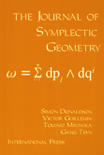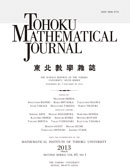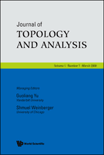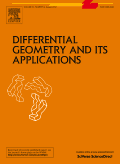
Journal of Computational Geometry
Scope & Guideline
Connecting Theory and Application in Geometry
Introduction
Aims and Scopes
- Algorithm Development and Optimization:
The journal consistently focuses on the development of new algorithms for various geometric problems, emphasizing their efficiency and applicability to real-world scenarios. - Geometric Data Structures:
A significant area of research includes the design and analysis of geometric data structures, which are crucial for efficiently storing and manipulating geometric information. - Topological and Geometric Relations:
The studies often explore the relationships between geometric and topological concepts, providing insights into how these fields intersect and inform each other. - Applications in Computer Science and Related Fields:
The journal highlights the application of computational geometry in diverse areas such as computer graphics, robotics, geographic information systems (GIS), and data analysis. - Theoretical Advances:
The publication features theoretical advancements in computational geometry, including complexity analysis and lower bounds for various geometric problems.
Trending and Emerging
- Persistent Homology and Topological Data Analysis:
Recent papers indicate a growing interest in persistent homology and its applications to topological data analysis, showcasing the relevance of topology in understanding complex data structures. - Geometric Algorithms in Machine Learning and Data Science:
There is an increasing trend toward applying geometric algorithms in machine learning and data science, highlighting the importance of geometric insights in processing and analyzing large datasets. - GPU and Parallel Computing Techniques:
The utilization of GPU and parallel computing for geometric computations is on the rise, reflecting the need for faster and more efficient processing methods in computational geometry. - Dynamic and Adaptive Algorithms:
A significant trend is the development of dynamic algorithms that adapt to changes in data, which is crucial for real-time applications in various fields such as robotics and computer graphics. - Interdisciplinary Applications:
There is a notable increase in research exploring interdisciplinary applications of computational geometry, particularly in fields like biology, physics, and network analysis, indicating a broadening of the journal’s scope.
Declining or Waning
- Basic Geometric Constructions:
There is a noticeable decrease in publications focusing solely on fundamental geometric constructions, indicating a shift towards more complex and applied geometric problems. - Classical Geometric Problems:
Classical problems such as basic triangulation or convex hull algorithms seem to be receiving less attention, as researchers pursue more innovative and computationally intensive topics. - Static Geometric Algorithms:
Research that focuses on static algorithms, which do not consider dynamic changes in data, appears to be waning, likely due to the increased importance of dynamic algorithms in practical applications.
Similar Journals

SIAM Journal on Applied Algebra and Geometry
Elevating Understanding through Rigorous Mathematical InquirySIAM Journal on Applied Algebra and Geometry, published by SIAM Publications, is a premier academic journal that occupies a vital space in the fields of Algebra, Geometry, and Applied Mathematics. With an impressive impact factor reflected in its Q1 category rankings in 2023 across key mathematical disciplines such as Algebra and Number Theory, as well as Geometry and Topology, this journal is positioned among the highest echelons of mathematical research. Since its inception in 2017, it has become a crucial source for advanced studies and applied techniques that harness algebraic and geometric methods, catering to both theoretical insights and practical applications. Researchers, professionals, and students alike benefit from its rigorous peer-reviewed articles that explore contemporary challenges and developments in mathematics. While Open Access options are currently not available, the journal remains dedicated to fostering innovation and knowledge dissemination within the scientific community, thus ensuring significant contributions to the advancement of the mathematical sciences.

Journal of Dynamical Systems and Geometric Theories
Transforming Knowledge in Dynamical SystemsJournal of Dynamical Systems and Geometric Theories, published by TARU Publications, is a prominent platform dedicated to advancing knowledge in the fields of dynamical systems and geometric theories. With an ISSN of 1726-037X and an E-ISSN of 2169-0057, this journal serves as a vital resource for researchers, professionals, and students who are keen on exploring the complexities of mathematical models and their applications in various scientific disciplines. Though currently listed as non-open access, the journal provides robust, peer-reviewed content that is essential for fostering innovative research and development. Situated in New Delhi, India, the Journal of Dynamical Systems and Geometric Theories is committed to disseminating high-quality scholarly articles that address both theoretical and practical issues related to dynamical systems, enhancing understanding and stimulating further academic discourse. To learn more about submission guidelines and access options, please visit the journal’s official webpage.

Journal of Symplectic Geometry
Pioneering research for a dynamic mathematical landscape.Journal of Symplectic Geometry, published by INT PRESS BOSTON, INC, is a premier outlet for research in the rapidly evolving fields of geometry and topology. With an ISSN of 1527-5256 and an E-ISSN of 1540-2347, this journal has established itself as a vital resource for scholars, featuring innovative research and comprehensive surveys that delve into the intricacies of symplectic geometry and its myriad applications. Boasting an impressive Q1 ranking in Geometry and Topology for 2023, the journal is dedicated to fostering a collaborative academic environment, attracting contributions from esteemed mathematicians worldwide. While the journal maintains a subscription-based model, it continues to prioritize disseminating high-quality research that propels advancements in the field. Researchers, professionals, and students alike will find the Journal of Symplectic Geometry indispensable for staying updated on the latest developments and contributing to ongoing discussions within the symplectic community, spanning from 2009 to 2024.

JOURNAL OF GEOMETRIC ANALYSIS
Catalyzing Discoveries in the Realm of GeometryJOURNAL OF GEOMETRIC ANALYSIS, published by SPRINGER, stands as a premier platform for the dissemination of high-quality research in the field of geometric analysis. With its ISSN 1050-6926 and E-ISSN 1559-002X, this prestigious journal has maintained a robust academic reputation since its inception in 1991, boasting a convergence of ideas and research that will continue through 2024. It is categorized in the top quartile (Q1) of Geometry and Topology, highlighting its significance and influence in the mathematical community. Ranking 23rd out of 106 in its field, and placing in the 78th percentile according to Scopus metrics, this publication is essential for researchers, professionals, and students who seek to deepen their understanding of geometric structures and their applications. Though it operates under a subscription model rather than Open Access, the journal consistently aims to advance knowledge through rigorous peer-reviewed articles that explore the latest developments and methodologies in geometric analysis, making it a pivotal resource for anyone involved in mathematical research.

TOHOKU MATHEMATICAL JOURNAL
Exploring Diverse Horizons of Mathematical ThoughtTOHOKU MATHEMATICAL JOURNAL, published by TOHOKU UNIVERSITY, is a distinguished academic journal committed to the advancement of mathematical research. Established in 1949, the journal has sustained a long-standing tradition of disseminating high-quality, peer-reviewed articles that contribute significantly to various branches of mathematics. With its scope encompassing a broad range of topics within the field, TOHOKU MATHEMATICAL JOURNAL aims to foster intellectual exchange and innovation among mathematicians worldwide. Though currently not an open-access publication, it is indexed in Scopus, holding a respectable Q2 ranking in the miscellaneous mathematics category as of 2023, which signifies its relevance and influence in the academic community. Researchers, professionals, and students alike will find valuable insights and contemporary developments that reflect the journal's dedication to excellence in mathematical scholarship.

JOURNAL OF GEOMETRY AND PHYSICS
Unraveling the Mysteries of Space and ShapeThe JOURNAL OF GEOMETRY AND PHYSICS is a distinguished peer-reviewed journal published by Elsevier, dedicated to fostering the exploration and dissemination of research at the intersection of geometry and physics. Established in 1984, this journal covers a broad range of topics, including the theoretical aspects of geometry, topology, and mathematical physics, making it an essential resource for researchers and practitioners in these fields. With an impressive Q2 ranking in various categories, including Geometry and Topology, Mathematical Physics, and General Physics and Astronomy, the journal ranks among the top 25% of its peers, reflecting its significant impact in advancing relevant discourse. Although currently not offered as an open-access publication, it maintains a strong readership due to its contribution to high-quality scholarly articles and critical reviews. The journal’s commitment to stimulating innovative research continues to solidify its reputation as a pivotal platform for exchanging ideas and fostering collaboration within the scientific community.

Journal of Topology and Analysis
Connecting Ideas in Topology and Analytical TheoryJournal of Topology and Analysis, published by WORLD SCIENTIFIC PUBL CO PTE LTD, is a distinguished peer-reviewed journal that focuses on advanced topics in mathematics, specifically within the fields of topology and analysis. Established in 2009 and running through 2024, the journal is based in Singapore and strives to present cutting-edge research that contributes to the mathematical community's understanding of geometric structures and analytical theories. Holding a respected position with a Q2 ranking in Analysis and a Q3 ranking in Geometry and Topology according to the 2023 category quartiles, the journal is indexed in Scopus, where it ranks #49 in Geometry and Topology and #118 in Analysis, showcasing its significance in the scholarly landscape. The Journal of Topology and Analysis aims to foster interdisciplinary collaboration by providing a platform for researchers, professionals, and students to share innovative findings and insights. Although it does not currently offer open access, its contributions are vital for advancing knowledge in these mathematical domains.

Cambridge Journal of Mathematics
Empowering Researchers with Cutting-Edge InsightsCambridge Journal of Mathematics, published by INT PRESS BOSTON, INC, is a premier platform for the dissemination of cutting-edge research in the field of mathematics. With an ISSN of 2168-0930 and E-ISSN 2168-0949, this journal stands out in a competitive academic landscape, currently ranked #58 out of 399 in General Mathematics, placing it in the top 15% within its category according to Scopus metrics. The journal serves as a vital resource for researchers, professionals, and students alike, aiming to foster groundbreaking mathematical inquiries and foster collaboration across disciplines. Published from 2020 to 2024, the Cambridge Journal of Mathematics is committed to maintaining high standards of scholarship, making it an essential read for those who are passionate about advancing mathematical knowledge and its applications.

DIFFERENTIAL GEOMETRY AND ITS APPLICATIONS
Unveiling Complex Geometrical FrameworksDIFFERENTIAL GEOMETRY AND ITS APPLICATIONS, published by Elsevier, is a premier academic journal primarily focused on the intricacies of differential geometry and its wide-ranging applications in various fields, including mathematics and theoretical physics. Established in 1991 and currently exploring relevant advancements through 2024, this journal serves as a vital platform for disseminating high-quality research that integrates theory and computational methodologies.With an ISSN of 0926-2245 and an E-ISSN of 1872-6984, it holds a significant position within the mathematical community, evidenced by its current quartile ranking of Q3 in major categories such as Analysis, Computational Theory and Mathematics, and Geometry and Topology. While open access options are not available, the journal's contributions are pivotal for researchers seeking to enrich their understanding of complex geometrical frameworks and their practical applications. As the landscape of differential geometry evolves, this journal stands out as a crucial resource for fostering innovation and collaboration among scholars and practitioners alike.

DISCRETE & COMPUTATIONAL GEOMETRY
Bridging Theory and Application in GeometryDISCRETE & COMPUTATIONAL GEOMETRY is a prestigious journal published by Springer, specializing in the fields of computational geometry, discrete mathematics, and theoretical computer science. With its ISSN 0179-5376 and E-ISSN 1432-0444, this journal has established itself as a key resource for researchers and professionals, offering a platform for the dissemination of high-quality research from 1986 to 2024. Recognized for its impact in the academic community, it currently holds a Q2 ranking in several important categories, including Computational Theory and Mathematics, Discrete Mathematics and Combinatorics, Geometry and Topology, and Theoretical Computer Science. Although it is not an open-access journal, the rigorous peer-review process ensures that published articles meet the highest standards of scientific integrity and scholarship. With Scopus rankings reflecting its influence—placing it in the 72nd percentile for Geometry and Topology and 62nd for Discrete Mathematics—it serves as an essential reference for students and scholars seeking to deepen their understanding of complex geometric and combinatorial theories.